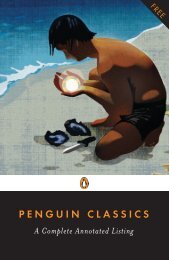Atlas Shrugged Teachers' Guide
Atlas Shrugged Teachers' Guide
Atlas Shrugged Teachers' Guide
Create successful ePaper yourself
Turn your PDF publications into a flip-book with our unique Google optimized e-Paper software.
ethics of egoism and the politics of individualism, i.e., the moral right of a man to his own life,<br />
and the political code of an individual’s inalienable rights which must be protected, not violated,<br />
by the state. Galt and his allies uphold a system of limited government and political/economic<br />
freedom, a laissez-faire society that liberates the great creative minds to develop new ideas and<br />
products, one which protects the rights of all men to keep the product of their effort. By refusing<br />
to allow their brains to be exploited by the dictators, they intend to bring collapse to the slavedriving<br />
system, resulting in the opportunity to establish a free, capitalist system.<br />
Though Dagny agrees with their philosophy, she is not ready to abandon her railroad, and<br />
she returns to the world. But she and Galt are in love. Because Galt is a striker, however, and<br />
Dagny a “scab,” it is uncertain that their relationship can ever be fulfilled.<br />
Galt has known all along that it is men and women like Rearden and Dagny who are his<br />
main enemy. Dictators are men of force, not of the mind, and consequently are incapable of<br />
creative achievements. They do not invent, innovate or advance; they loot the creations of others,<br />
and when the creators have been killed, their systems collapse into abysmal squalor. It is Dagny<br />
and Rearden who inadvertently prop up the looter’s regime, because it is only their enormous<br />
productivity that prevents it from just such a collapse. Galt understands that the strikers’<br />
ultimate success requires that all of the major producers, including Hank Rearden and Dagny<br />
Taggart, join them. Consequently, the real conflict in <strong>Atlas</strong> <strong>Shrugged</strong> is not between strikers and<br />
management (the government), but between strikers and scabs.<br />
With the U.S. economy crumbling because of the government’s increasingly socialistic<br />
policies, the president, Mr. Thompson, is due to address the nation regarding the causes of the<br />
current emergency. Instead, Galt, using the incalculable power of his motor, pre-empts Mr.<br />
Thompson on the airwaves, and addresses the nation. He informs the American people that the<br />
men of the mind are on strike—and why—and what are the conditions of their return.<br />
The dictators, realizing that Galt is a genius, believe they must capture him and convince<br />
him to devise an economic “plan” that will rescue the country from the disastrous consequences<br />
of their policies. Knowing that Dagny, though not a striker, thinks like Galt, they have her<br />
surreptitiously followed, hoping that she will lead them to him. Fearing for his safety, she goes<br />
to him, inadvertently leading to his apprehension.<br />
Galt refuses to join the dictators. Desperate, they torture him, but he is rescued by his fellow<br />
strikers, joined now by Dagny and Rearden. They return to the valley, where Galt and Dagny<br />
are free to pursue their relationship. Finally, the corrupt statist regime collapses, and the strikers<br />
prepare to return to the world, where they will build history’s freest society.<br />
In her book The Romantic Manifesto, Ayn Rand coined a conceptual tool of literary analysis<br />
which she termed the “plot-theme.” A literary work’s plot-theme is the abstract essence of its<br />
story, of its events, presented in a succinct formulation. The plot-theme of <strong>Atlas</strong> <strong>Shrugged</strong> is: the<br />
men of the mind go on strike against an altruist-collectivist society, i.e., against the moral code<br />
of self-sacrifice and the politics of enslaving the individual to the group.<br />
4<br />
<strong>Atlas</strong> <strong>Shrugged</strong>–—Teachers’ <strong>Guide</strong> 1<br />
(c) Ayn Rand Institute 2003

















